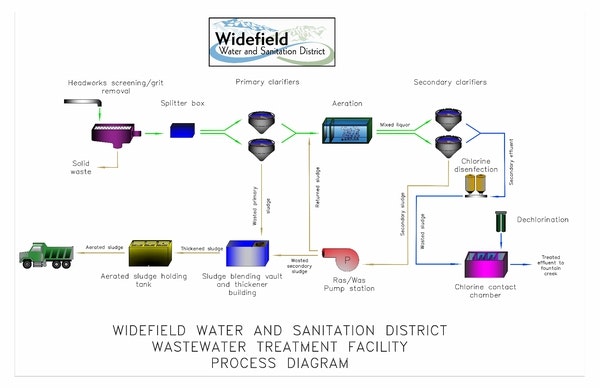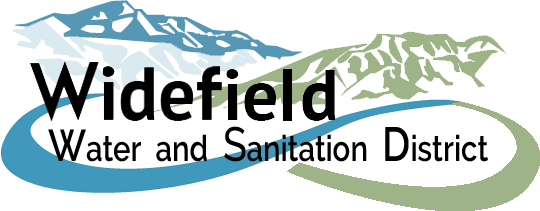Wastewater - FAQ
General Questions
When a stoppage occurs, you should contact the District immediately at 719-392-8848; this emergency number is monitored 24 hours a day, 7 days a week, including holidays. Wastewater personnel will come out to the site and assess the stoppage to determine if the obstruction is on the District’s side of the sewer line or the homeowner's sewer service line. The District will clear any blockage that occurs in the District’s sewer main. Customers are responsible for blockages that occur in their sewer service line which is located between the District’s sewer main (which is usually located in the middle of the street) and the customer’s home.
You can set up a maintenance schedule to include annual cleaning of your service line with a private service company, or you may need to have your service line videotaped to check its condition. You may also want to consider removing any large trees removed from areas that could affect your service line.
The homeowner is responsible for cleanup and repair costs associated with sewer back-ups. Please contact your insurance company to report the problem, or contact a restoration business of your choice to do the remediation work. The District has a list of service providers which perform this type of work.
Most sewer backups happen because the pipe is plugged with debris. However, backups can be caused by several factors, including the condition of the sanitary sewer system itself, natural phenomena such as earth movement or roots, and the incorrect usage of the system by the public.
Some common backup causes are:
- Solids / Debris – Typical solids that build up in the pipe and cause backups are fats, oil, grease (FOG), dirt, hair, bones, sanitary products, paper towels, kitty litter, diapers, broken dishware, garbage, concrete, and debris. When oil or grease is discharged into a sewer system, it will solidify and, after a while, oil and grease can build up and plug drain lines in your home or building. Oil and grease can also plug the sewer lines and clog pump stations owned by the District, thus increasing the maintenance costs to customers. Plugged sewers can cause flooding of nearby homes and businesses as well as result in sanitary sewer overflows.
- Tree Root Infiltration – Tree roots can cause backups. Tree roots are attracted to sewer lines because of the sewer waters’ warm temperatures and food nutrients found in the sewers. Roots can infiltrate the pipe system and clog the wastewater flow.
Do not flush disposable diapers and baby wipes as they will clog your sewer line. In addition, never pour grease or gummy substances down garbage disposals, toilets, or floor drains. Flammable liquids, i.e. used motor oil, gasoline, paint thinner, etc., should never be poured into your sewer line as they can cause a fire hazard or create a harmful coating on your sewer pipe. Never flush plastic tampon containers, pencils, pins, hypodermic needles, broken glass or other foreign objects that can lodge in your sewer service line and cause a sewer back-up.
Believe it or not, a dry drain can lead to this condition. Drain pipes are constructed to hold a small amount of water. This retained water creates a seal to keep odors from coming up into your house from the sewer system. This water seal can evaporate over time, thus allowing foul odors to come into your house. To remedy this situation, you should pour a little water down your drain each month.
The District’s Wastewater Department has implemented a preventative maintenance program of sewer cleaning and condition assessment of the entire sewer collection system. The periodic cleaning and video taping of the sewer lines in your neighborhood can reduce the risk of any grease or root buildup which reduces the likelihood of sewer back-ups and/or sanitary sewer overflows.
All wastewater plants and sewer lines generate odors to some degree and are caused by many factors associated with fecal matter (human waste). Odors may vary in intensity from time-to-time, but will generally be more noticeable as wind carries them in the direction of homes.
Sludge is removed from the digesters approximately once per month which usually takes 2-3 days to complete. You may notice an increase in odors during this operation, but they are significantly reduced once the process is completed.
Primary treatment removes 40-50% of the solids. Sanitary sewers carry wastewater from homes and businesses to the treatment plant. Bar screens let water pass, but not trash. The trash is collected and properly disposed. A grit chamber is a large tank that slows down the flow of water. This allows sand, grit, and other heavy solids to settle at the bottom for removal later.
Secondary treatment completes the process, so that 85-95% of the pollutants are removed. A secondary sedimentation tank allows the microorganisms and solid wastes to form clumps and settle. Some of this mixture, called "activated sludge," can be mixed with air again and reused in the aeration tank. A disinfectant, such as chlorine, is added to the wastewater before it leaves the treatment plant. The disinfectant kills disease-causing organisms in the water. After treatment, the water can be returned to nearby waterways. It can also be used on land for agriculture and other purposes.

A. Wastewater treatment plant:
- Removes Solids - This includes everything from rags and sticks to sand and smaller particles found in wastewater.
- Reduces Organic Matter and Pollutants - Helpful bacteria and other microorganisms are used to consume organic matter in wastewater. The bacteria and microorganisms are then separated from the water.
- Restores oxygen - Treat
